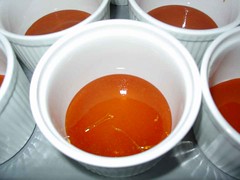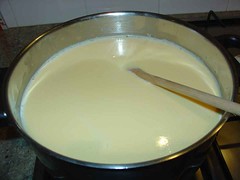This Creme Caramel isn't the easiest thing to make, not first time anyway. Like all things that involve boiling sugar, it is fraught with risk. The first time I made this, I burnt the caramel three times and two fingers. It was not exactly the most enjoyable experience and I wanted to chuck it all in and give up when I had three burnt pots in the sink and the whole kitchen smelt of burnt sugar. Luckily, I persevered and the results were amazing. My creme caramel tasted very much like the one I had at Movida. It is very rich and creamy and just goes down your mouth so easily. The difference is that I must have cooked the milk a bit too long because the texture was a bit rough. The second time I made it, I also followed the recipe and it turned out the same. Hence, next time, I'm going to try not boiling the milk as long and seeing how that works out.
My tip for making the caramel is to watch it extremely closely. The original recipe said not to stir the sugar at all, but I found it would start to burn on the edges of the pan. Hence, you can stir it I found, but you should control the heat very closely. And don't wait for the caramel to go golden. Once all the sugar has melted, you can pretty much take it off the heat and it will get darker in colour.

Creme Caramel (Flan De Nata)
Ingredients
500 g caster sugar
500 ml milk
500 ml whipping cream
2 whole eggs at room temperature
9 egg yolks at room temperature
Method
1) Caramelize 300 g of the sugar in a heavy based saucepan over high heat for 5 minutes. Stir the sugar occasionally when the edges start to melt and darken in colour. Reduce the heat to medium and continue cooking for 1-2 minutes until all the sugar has melted. Stirred as required.
2) Quickly spoon 2 tablespoons of the caramel into the bottom of seven 200 ml ramekins. Place all the ramekins into a roasting tray.

3) Combine the milk and cream in a saucepan over medium heat. Just before the milk boils, take it from the heat and allow to cool for 10 minutes. Preheat oven to 170 C.
4) Combine the whole eggs, egg yolks and remaining 200 g of sugar in a bowl. Which until lightly combined.
5) Gradually pour 250 ml of the milk/cream mixture onto the egg and sugar while gently whisking. Add the remainder of the milk and cream mixture. Pour everything back into a heavy based saucepan over low to medium heat.
6) Stir the mixture for 10 - 12 minutes until the back of a wooden spoon is coated when dipped into the mixture. Ladle mixture into the ramekins.

7) Pour enough hot water into the roasting tin to fill up to 1 cm from the top of the ramekins. Place tray into oven.
8) Cook for 1 hour. Test if done by inserting knife into the centre of one custard right to the bottom. Pull knife to one side and if caramel rises, it is done. Set custards overnight in fridge.

9) To serve, run knife around the edge of the ramekins and carefully invert.
Thanh, my favourite is Flan de Queso - creme caramel in a sense but made with philadelphia cream cheese instead of cream - THE best! Most mexican restaurants serve it... Vida x
ReplyDeleteVida, that desserts sounds great too. Do you have a recipe for it?
ReplyDeleteG'day Thanh. What you're trying to make is a custard which sets gently in the oven. The rough texture you describe is curdled ('split') custard, caused by cooking it too long in the oven. The egg proteins contract due to the prolonged heating and the gel which has formed breaks as the contracting proteins squeeze out some of the moisture they had previously bound.
ReplyDeleteSo, don't worry about how long you boil the milk for (in fact, you just need to get it barely boiling and then stop, but longer won't harm the custard, other than perhaps changing the flavour slightly). You *absolutely* need to worry about how long the custards are in the oven. It's the same principle as for quiches or custard tarts. A custard is usually just set when the middle of the surface still seems a little runny when you jiggle the ramekin. It might not quite be set enough for a creme caramel, but it's worth experimenting with.
Thank you so much Duncan. You have saved me much experimenting. I was going to try boiling it less first. Then the next step was to test the oven temp. Then it was how long in the oven. I will try cooking it for less time next and see what happens.
ReplyDeleteI suggest 150 celcius for about 20 - 30 minutes
ReplyDelete